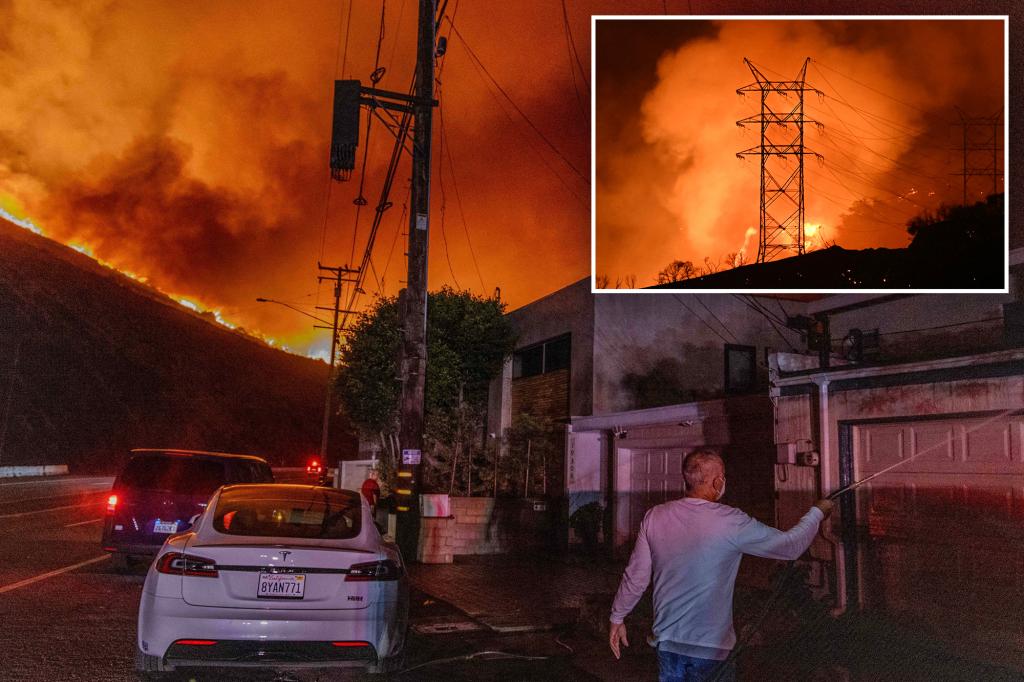The devastating wildfires that recently ravaged Los Angeles County have left a trail of destruction, claiming lives, homes, and vast swathes of land. Amidst the ongoing efforts to contain the blazes and assess the damage, questions have arisen regarding the potential role of Southern California Edison (SCE), a major power company, in igniting some of the fires. Specifically, the company’s decision to keep its electrical transmission lines energized despite high winds has come under intense scrutiny.
SCE CEO Steven Powell has defended the company’s actions, asserting that the wind speeds recorded prior to the outbreak of the Eaton Fire, one of the most destructive blazes, did not meet the threshold for de-energizing the transmission lines. According to Powell, SCE typically shuts down power lines when wind speeds reach 60-80 mph. While acknowledging the presence of strong winds in the area, Powell maintained that the recorded speeds fell short of this critical benchmark. However, weather service data indicates that wind gusts of 59 mph, just 1 mph below the cutoff, were recorded around the time the Eaton Fire was first reported. Furthermore, even stronger gusts of up to 63 mph were registered in the region just hours before the fire’s eruption. This discrepancy between SCE’s internal data and the weather service’s recordings raises questions about the accuracy and reliability of the company’s wind monitoring systems. The precise wind speed at the location of the suspected electrical tower remains unclear, further complicating the investigation into the fire’s origin.
Despite the mounting evidence suggesting a possible link between SCE’s equipment and the Eaton Fire, Powell maintains that the company’s data reveals no abnormalities in the 12 hours leading up to the blaze. While investigators have yet to definitively determine the cause of the fire, several eyewitnesses have reported seeing flames at the base of an SCE transmission tower. These accounts, coupled with videos circulating on social media that appear to show sparks emanating from the tower, have fueled public suspicion and led to numerous lawsuits against the company. Powell, while acknowledging the distressing nature of the videos, has cautioned against drawing premature conclusions based on limited visual evidence. He emphasizes the need for a thorough investigation to determine the true cause of the fire before assigning blame.
The controversy surrounding SCE’s potential role in the wildfires highlights the complex and often contentious relationship between power companies and the communities they serve. While power lines are recognized as a potential fire hazard, particularly in dry and windy conditions, the decision to de-energize them is not without consequences. Power outages can disrupt essential services, impact businesses, and create significant inconvenience for residents. Balancing the risk of fire ignition with the need to maintain a reliable power supply is a delicate act, requiring careful consideration of various factors, including weather conditions, terrain, and the age and condition of the power infrastructure. In light of the recent wildfires, the adequacy of SCE’s existing protocols and the accuracy of its wind monitoring systems are likely to come under intense scrutiny.
The devastating impact of the wildfires has underscored the urgent need for improved fire prevention and mitigation strategies. As climate change continues to exacerbate drought conditions and increase the frequency and intensity of extreme weather events, the risk of wildfires is expected to grow exponentially. This necessitates a proactive and multifaceted approach that encompasses both short-term measures, such as enhanced vegetation management around power lines and improved early warning systems, and long-term solutions, such as investing in more resilient power grids and promoting fire-resistant construction. The ongoing investigation into the cause of the Eaton Fire will undoubtedly inform future policy decisions and industry practices aimed at minimizing the risk of similar tragedies in the years to come.
The unfolding situation in Los Angeles County serves as a stark reminder of the devastating consequences of wildfires and the importance of preparedness. While the exact cause of the Eaton Fire remains under investigation, the potential involvement of SCE’s equipment raises serious questions about the company’s safety protocols and the adequacy of its response to extreme weather conditions. The lawsuits filed against SCE and the ongoing public debate underscore the need for greater transparency and accountability within the power industry. As communities grapple with the aftermath of these devastating fires, a comprehensive review of existing fire prevention and mitigation strategies is essential to safeguard lives, property, and the environment from future wildfire threats. The lessons learned from this tragedy will undoubtedly shape the way we manage and mitigate wildfire risks in the face of a changing climate.

